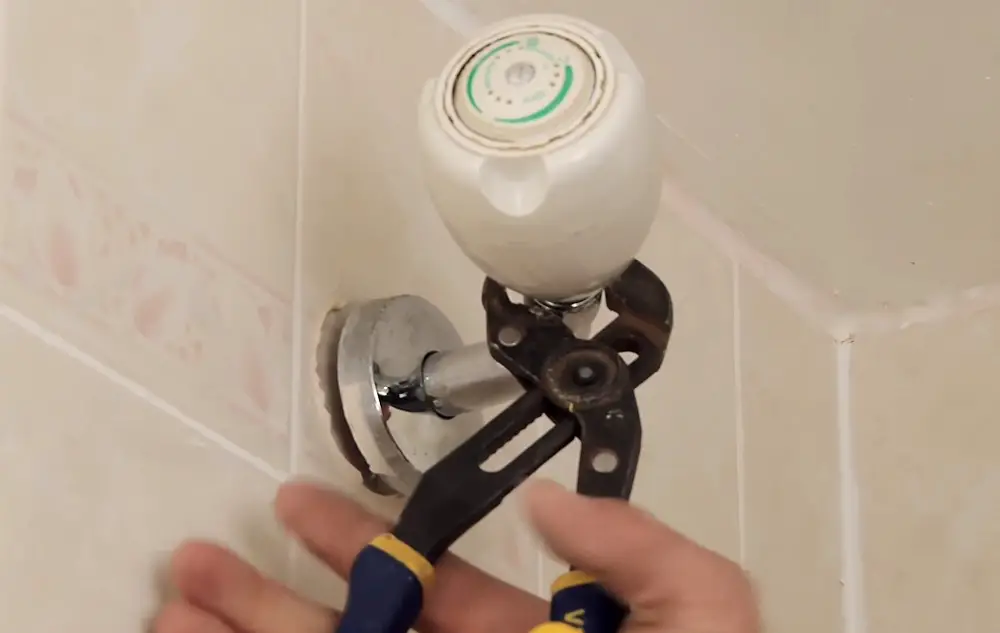Hey! This site is reader-supported and we earn commissions if you purchase products from retailers after clicking on a link from our site.

If you are wanting to install a new shower arm and head, you’ll first have to remove the old ones. Your shower arm and showerhead can be removed at the same time as a single unit. In order to remove your shower arm, you will need to gather a few items together. The process that you will use to remove it will depend on whether or not it is stuck.
Step one: Collect the materials that you will need
Before you get started, collect the materials that you will need, including the following:
- Adjustable pipe wrench
- Calcium and lime remover
- Lubricant spray
- Vinegar
- Vise grips
- Stepladder
- Cloth
- Rubber gloves
Step two: Turn off the water to your shower
The next step is to turn off the water to your shower. You can do this by turning the water off at the valve that is located behind the shower. Alternatively, you can turn off the water to the bathroom itself.
Step three: Use your vise grips

Climb your stepladder and place your vise grips on the shower arm. With your adjustable pipe wrench, turn the showerhead nut in a counterclockwise direction. If the shower arm does not turn, do not force it or it might break.
Step four: Inspect your shower arm closely
If your shower arm would not loosen, take a close look at where the shower arm attaches to the shower pipe. If you see white specks and flakes, you have calcium or mineral deposits. If there are rust specks, the threads may be corroded.
Step five: Remove any mineral or rust buildup that you see
In order to remove mineral buildup or rust, start with the vinegar. Put on your rubber gloves, and soak a cloth in vinegar. Wrap it around where the shower arm is attached to the shower pipe. Leave it in place for about 10 minutes. Then, wipe it off. If the minerals or rust appear to be gone, attempt to remove the shower arm with your adjustable pipe wrench. If the rust or mineral buildup is still there, try to remove them with your calcium and lime remover.
Wipe your shower arm off with a dry cloth. Pour some of the calcium and lime remover on the nut. Then, soak another cloth in some of the remover and place it on the shower arm where it connects to the shower pipe. Leave the cloth in place for a minimum of 20 minutes. Then, try to turn the shower arm again, but don’t force it if it still won’t move.
Step six: Use lubricant
If the calcium and lime remover did not work, wipe all of the residue off using warm, soapy water and a cloth. Then, dry it with a dry cloth. Spray the lubricant on the threads and allow the lubricant to remain for approximately two hours. Try to remove the shower arm again. If it still won’t budge, don’t force it because you could damage the shower riser pipe. If you are unable to remove your shower arm using all of these steps, you should call a professional plumber for help.
Removing a shower arm can be difficult if it has corroded or if substantial mineral deposits have built up. You can attempt to remove your shower arm with the outlined steps. If all else fails, a plumber can help. Once it’s removed, and you’ve installed a new shower arm, spray around it with vinegar occasionally to help to prevent minerals from building up again.
Serious about upgrading your shower? We created a special guide for you. We evaluated hundreds of shower heads and narrowed down our discovery to these 12 shower heads that we think are the best of the best. Whether you love intense high pressure, soothing rainfall, saving water, or rocking out to music in the shower – we’re confident you’ll find the perfect fixture for you.
